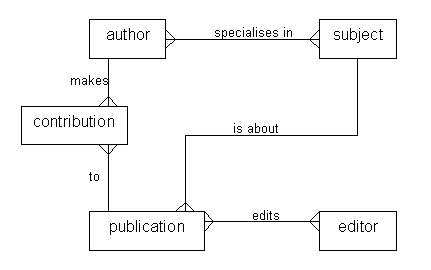
This is the second-best answer. Although logically this relationship does become many-to-many, it is also parameterised as we also have to store the percentage of the components concerned with each subject. Simply putting in a many-to-many does not allow us to parameterise the relationship.

Author-publication is currently a parameterised many-to-many relationship. It has no involvment with subject, which is what we are trying to manipulate.

What we really want is a parameterised many-to-many relationship between subject and publication. To draw this in the ER Diagram, we would have to create a new entity type between subject and publication (lets call it "share"). There would be a one-to-many relationship between publication and share, and a many-to-one between share and subject.
A publishing company produces academic books on various subjects. Books are written by authors who specialise in one or more particular subject. The company employs a number of editors who do not have particular specialisations but who take sole responsibilty for for editing one or more publications. A publication covers a single subject area but may be written by one or more author - the contribution of each author is recorded as a percentage for the purposes of calculating royalties.
The following ER diagram is intended to represent the above specification:

The specification is to be changed so that an author can develop a publication covering more than one subject area and that the schema must be able to store the percentage of the compents concerned with each of the subjects. Select an appropriate change to the ER diagram:
- publication-subject becomes many to many
- author-subject becomes many to many
- author-publication becomes many to many
- more than one of the above
- none of the above
| ||||
| ||||
|